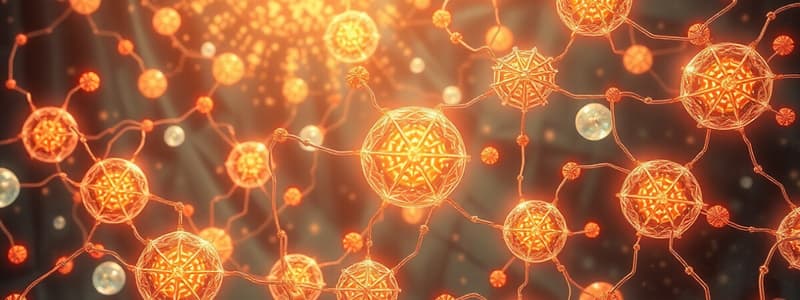Podcast
Questions and Answers
What type of ion is formed when metals lose electrons?
What type of ion is formed when metals lose electrons?
- Anion
- Radical
- Molecule
- Cation (correct)
Which of the following represents a common charge for Group 16 elements?
Which of the following represents a common charge for Group 16 elements?
- -2 (correct)
- -1
- +2
- +3
What is the relationship between ionic radii and lattice energy?
What is the relationship between ionic radii and lattice energy?
- Ionic radii have no effect on lattice energy.
- Smaller ionic radii result in a stronger attraction between ions. (correct)
- Larger ionic radii increase lattice energy due to expanded distance.
- Larger ionic radii lead to more negative lattice energy.
What does lattice energy depend on?
What does lattice energy depend on?
What is a characteristic of Group 14 elements regarding electron loss or gain?
What is a characteristic of Group 14 elements regarding electron loss or gain?
Which ion has a greater positive charge than sodium (Na)?
Which ion has a greater positive charge than sodium (Na)?
Which of the following represents the correct formula for calculating lattice energy?
Which of the following represents the correct formula for calculating lattice energy?
What is the typical charge for chlorine ions?
What is the typical charge for chlorine ions?
What happens to the size of cations compared to their parent neutral atoms?
What happens to the size of cations compared to their parent neutral atoms?
Which ion has the largest ionic radius among the following?
Which ion has the largest ionic radius among the following?
If an ion has a charge of -2, how does its ionic radius compare to a -1 charged ion?
If an ion has a charge of -2, how does its ionic radius compare to a -1 charged ion?
What is the total distance $R$ between Na+ and Cl− ions in NaCl?
What is the total distance $R$ between Na+ and Cl− ions in NaCl?
How does the ionic radius of Mg2+ compare to that of Na+?
How does the ionic radius of Mg2+ compare to that of Na+?
Which pair of ions would have the smallest total distance $R$?
Which pair of ions would have the smallest total distance $R$?
In lattice energy calculations, what factor causes energy to increase?
In lattice energy calculations, what factor causes energy to increase?
Which statement about ionic radii is correct?
Which statement about ionic radii is correct?
Flashcards
Ionic Charge Determination
Ionic Charge Determination
Metals lose electrons to become positively charged ions (cations), while nonmetals gain electrons to become negatively charged ions (anions).
Cation Charge
Cation Charge
The positive charge on an ion, equal to the number of electrons lost by the metal atom.
Anion Charge
Anion Charge
The negative charge on an ion, equal to the number of electrons gained by the nonmetal atom.
Lattice Energy Formula
Lattice Energy Formula
Signup and view all the flashcards
Lattice Energy Factors
Lattice Energy Factors
Signup and view all the flashcards
Ionic Radius
Ionic Radius
Signup and view all the flashcards
Group 1 Ionic Charge
Group 1 Ionic Charge
Signup and view all the flashcards
Group 14 Special Case
Group 14 Special Case
Signup and view all the flashcards
Ionic Radius of Cations
Ionic Radius of Cations
Signup and view all the flashcards
Ionic Radius of Anions
Ionic Radius of Anions
Signup and view all the flashcards
Ionic Radius Trend (Cations)
Ionic Radius Trend (Cations)
Signup and view all the flashcards
Ionic Radius Trend (Anions)
Ionic Radius Trend (Anions)
Signup and view all the flashcards
Calculating Total Distance (R)
Calculating Total Distance (R)
Signup and view all the flashcards
Lattice Energy and Ion Charges
Lattice Energy and Ion Charges
Signup and view all the flashcards
Lattice Energy and Ionic Radius
Lattice Energy and Ionic Radius
Signup and view all the flashcards
Calculating Lattice Energy (Proportional)
Calculating Lattice Energy (Proportional)
Signup and view all the flashcards
Study Notes
Ionic Bonds and Charge Determination
- Ions are atoms or groups of atoms with a net positive or negative charge.
- Cations are positively charged ions formed when metals lose electrons. The charge equals the number of electrons lost.
- Example: Sodium (Na, Group 1) forms Na+ with a +1 charge.
- Example: Magnesium (Mg, Group 2) forms Mg2+ with a +2 charge.
- Anions are negatively charged ions formed when nonmetals gain electrons. The charge equals the number of electrons gained.
- Example: Chlorine (Cl, Group 17) forms Cl− with a −1 charge.
- Example: Oxygen (O, Group 16) forms O2− with a −2 charge.
- Common ionic charges by group:
- Group 1: +1
- Group 2: +2
- Group 13: +3
- Group 16: −2
- Group 17: −1
- Group 14 (Carbon Group) is a special case: can lose 4 electrons forming +4 ion or gain 4 forming −4 ions, but typically forms covalent bonds instead.
Lattice Energy
- Lattice energy is the energy needed to separate one mole of an ionic solid into its gaseous ions.
- Lattice energy is proportional to (charge of ion 1 * charge of ion 2) / (distance between ions).
- Higher charges result in stronger attractions and higher (more negative) lattice energy.
- Smaller ion radii lead to shorter distances and higher lattice energy.
- Factors Affecting Lattice Energy:
- Higher ion charges = Higher lattice energy.
- Smaller ion sizes = Higher lattice energy.
Determining Ionic Radii
- Ionic radius is the size of an ion in a crystal lattice, often different from the atomic radius.
- Cations are smaller than their corresponding neutral atoms, losing electrons.
- Anions are larger than their corresponding neutral atoms, gaining electrons.
- Ionic radius trends:
- Higher positive charge = Smaller ionic radius.
- Higher negative charge = Larger ionic radius.
- Example values:
- Na+: 102 pm
- Mg2+: 72 pm
- Cl−: 181 pm
- F−: 133 pm
Calculating Lattice Energy
- Find charges on ions
- Utilize ionic radii to determine the distance between the ions
- Use the formula to calculate the lattice energy.
Example Problems
- The examples demonstrate calculating proportional lattice energy using ion charges and ionic radii.
- Example Problems demonstrate the relationships between the quantities listed.
Studying That Suits You
Use AI to generate personalized quizzes and flashcards to suit your learning preferences.




